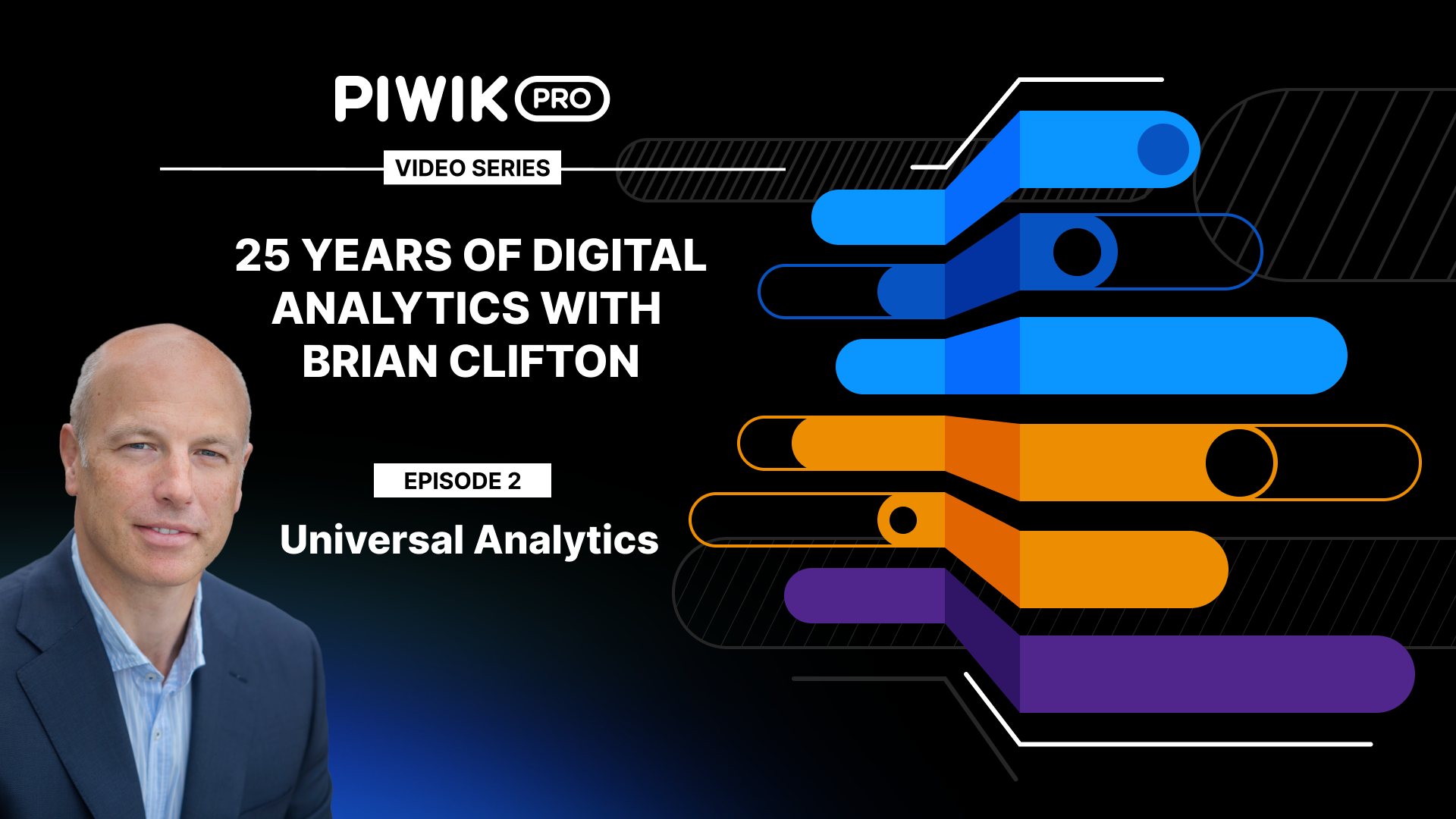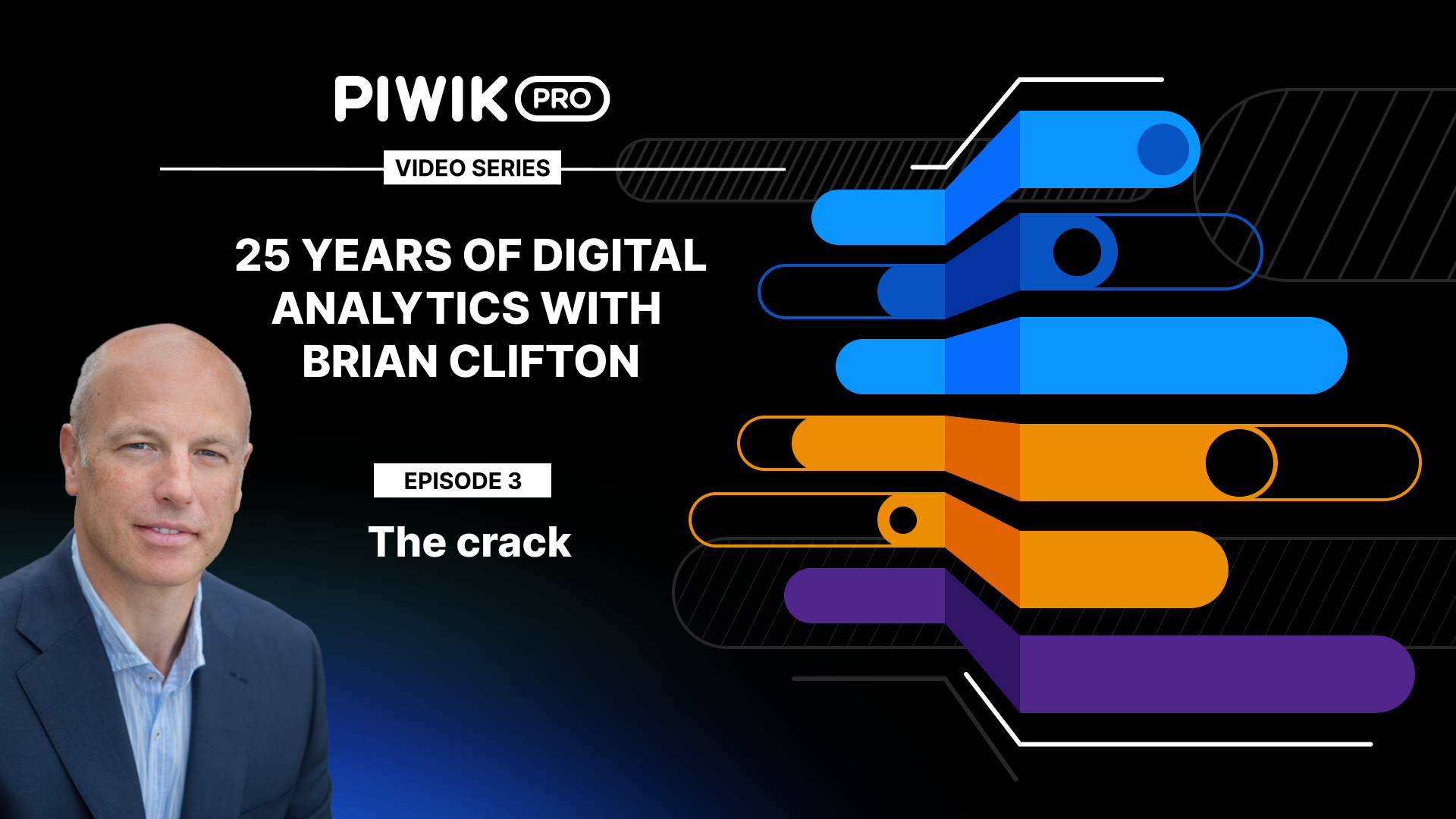From its beginning in the mid-1990s to the present day, digital analytics has undergone significant changes, shaped by technological advancements, evolving market demands, and regulatory landscapes.
Join us as we delve into the history of digital analytics, led by the renowned digital analytics and privacy expert Brian Clifton. Our video series comprehensively explores our industry’s history, technologies, and mindsets, giving you a deep understanding of digital analytics.
In this part of the series, Brian discusses the origins of web analytics, Google’s role in its development, the emergence of various web analytics vendors, and the ongoing challenges they face. You can watch the first three episodes in the corresponding parts of the article.
The beginnings of digital analytics
The developing internet landscape prompted the emergence of digital analytics, initially focused on understanding server performance and website traffic. The primary method back then was log file analysis, involving examining server log files to identify unique visitors. Analytics tools of the day were developed mostly for use by IT departments, to gauge server resource usage and performance.
In the mid-1990s, web analytics providers like Webtrends entered the market, offering tools to help IT departments understand and optimize their websites’ online presence. The introduction of cookies by Netscape in 1994 allowed for more sophisticated tracking of user behavior, providing advertisers with valuable insights into consumer preferences and online activities. However, the emergence of clickable banner ads is what truly pushed online measurement forward. By letting users interact directly with ads, advertisers could improve engagement and measure the effectiveness of their campaigns.
However, as the internet became more of a business platform, marketers started to recognize the value of measuring website performance for strategic purposes. The expansion of ecommerce platforms showed the need for robust analytics solutions to track and improve digital performance. This shift marked the beginning of a new era of marketing-related analytics.
Google enters the web analytics market
In November 2005, Google played a pivotal role in shaping the course of digital analytics with the launch of Google Analytics (GA). Recognizing the growing demand for user-friendly analytics tools aimed at the needs of marketers, the company released a platform that reshaped the industry and democratized data analysis.
“The great attraction for me was the idea that we were right at the tipping point of an industry, moving away from IT-related tools into marketing-related tools. And Google wanted to invest in that big time.”
Brian Clifton, Digital analytics and privacy expert
Google Analytics aimed to simplify data interpretation by offering intuitive reports that didn’t require specialized IT or analyst expertise. The platform’s launch was met with an overwhelmingly positive response, highlighting the need for accessible analytics solutions in the online advertising landscape.
Google made Google Analytics a free platform so that marketers could measure their ads’ effectiveness, while also increasing the money spent on ads, primarily in Google’s ad networks.
Previously, free versions of analytics platforms offered severely limited features and poor usability. GA, in the freemium version, was a fully usable tool that revolutionized the analytics industry, strengthening the community in several ways. Being free, it democratized access to analytics tools for many users, from beginners to experts, allowing them to manage their marketing data independently of IT departments. It also included powerful features so that marketers could go beyond optimizing campaigns for clicks and instead understand visitor engagement, purchases and conversions.
The introduction of Universal Analytics
The next most significant milestone in Google’s contributions to digital analytics was the introduction of Universal Analytics (UA) in 2012, which served as the cornerstone for digital marketers and analysts.
Universal Analytics reshaped how businesses understand and leverage user insights. It introduced a revamped user interface that revolutionized data visualization, offering intuitive ways to navigate and interpret vast amounts of information. Also, multi-channel funnels, real-time reporting, flow visualization, and data import enhanced the analytical capabilities, while the measurement protocol allowed offline conversions to be seamlessly integrated into Google Analytics.
Over the years, UA set a new standard in data analysis tools, with its comprehensive features and user-friendly interface. It has established itself as a mature product, designed to meet businesses’ diverse needs for tracking and analyzing campaign performance, user interactions and conversions.
The first obstacle – a focus on data privacy
Over time, privacy issues have arisen as a key challenge not only in the analytics landscape but also for society more broadly. It started with the whistleblower Edward Snowden’s leaks about the National Security Agency’s surveillance of Americans’ online and phone communications in June 2013. Then the Facebook/Cambridge Analytica debacle of 2016 exposed poor data governance in the commercial sector. These events were followed by the groundbreaking regulations of the EU General Data Protection Regulation (GDPR) in May 2018.
GDPR is the gold standard for data privacy regulations that inspired legislation around the world, such as Brazil’s LGPD, California’s CPRA, Canada’s CPPA, and Germany’s TTDSG. These privacy laws concentrate on requiring users to give explicit consent before processing their data.
To know more about privacy regulations, read: 17 new privacy laws around the world and how they’ll affect your analytics
The focus on data privacy forced analytics providers to adapt their platforms to comply with strict requirements. This has evolved into a major challenge as data collection practices have been closely monitored, raising concerns about user privacy.
“After the revelations about the US government by Edward Snowden, people began to realize that their online world was part of a mass commercial surveillance economy.”
Brian Clifton, Digital analytics and privacy expert
Universal Analytics sunset
One of the defining features of Universal Analytics was its reliance on cookies to track user activity. While this method was adequate for its time, the rapid spread of mobile devices and evolving privacy regulations highlighted its limitations. It became increasingly obsolete in an era dominated by mobile apps, cross-device usage, and privacy concerns.
Moreover, Google decided it was time to compete more effectively in the enterprise market, recognizing the need for a more sophisticated analytics solution that could adapt to the progressing digital landscape.
In October 2020, Google announced the sunset of Universal Analytics, signaling the end of an era and preparing for the next generation of digital analytics tools.
The introduction of Google Analytics 4
The UA sunset led to the development of Google Analytics 4 (GA4), which caters to the demands of large organizations with extensive data teams. GA4 is positioned to adjust to their needs, aligning with the trajectory set by tools like Adobe Customer Journey Analytics.
The data structure of GA4 is quite different from Universal Analytics. It introduced a more flexible event-based data model, deeper integration with Google’s machine learning capabilities and ad ecosystem, and enhanced cross-device tracking via its user-graph, Signals (Google account owners). All these features ensure a better understanding of user journeys, providing businesses with a more holistic view of user engagement. Also, it helps enhance audience segmentation and targeting.
However, the shift from Universal Analytics to GA4 introduced many challenges, especially for businesses accustomed to the more structured “marketing analytics” approach of Universal Analytics.
Return to the roots of digital analytics
Twenty years ago, analytics tools were designed for use by IT departments. Google’s initial strength was revolutionizing web analytics and focusing on the needs of marketers. With GA4, the landscape has changed again.
This shift has led to confusion among marketers who were accustomed to using analytics tools in a certain way. Google’s lack of clear guidance on GA4’s purpose and navigation has contributed to the problem, leaving users unprepared for this new platform. Many users feel apprehensive and uncertain about this change.
The switch to GA4 represents a departure from the marketer-centric approach toward a more technical audience with specialized data wrangling knowledge and skills. This change reflects a full-circle movement, returning to the early days of digital analytics, where the user requires a high degree of technical and analytical skills in order to get the most out of the product (and not be frustrated).
Privacy issues
Another significant challenge with Google Analytics 4 are privacy issues, particularly regarding compliance with European regulations such as GDPR. The major concern lies in storing user data, including that of EU residents, on US-based cloud servers, subjecting it to US surveillance laws (FISA 702).
Lack of user control over data is another issue, as Google retains rights to collected information and shares it across its various products, raising concerns about data security and privacy. Additionally, data residency requirements necessitate careful consideration, and data storage within the EU is strongly recommended to ensure compliance.
The “jigsaw effect”
The analytics products of Big Tech companies like Google are constantly under a hint of suspicion. They follow the digital footprints of users, gathering vast amounts of data, with little control for the user over how that data is used. Also, their primarily business model is advertising, hence personalized ad targeting is a major concern.
Many businesses are cautious about submitting their data to platforms that are focused on monetizing it for their own purposes, i.e. delivering personalized ads. Users also worry about their privacy and the potential for re-identification – the so-called “jigsaw effect.” The more digital footprints you collect and follow from users, the more likely the path becomes unique, and hence the more likely the owner of them can be identified.

The “jigsaw effect” shows the delicate balance between data aggregation and privacy protection. By embracing alternative analytics solutions, companies can navigate the complexities of data privacy while leveraging actionable insights to drive growth and innovation.
The rise of competitors
Privacy concerns and evolving data protection regulations are fuelling the rise of competitors to Google Analytics. Unlike Big Tech companies focused on advertising revenue, alternative analytics providers may have different business models that prioritize user privacy and data security. Also, they offer viable solutions for businesses reluctant to entrust their data to tech giants.
This shift towards privacy-centric analytics solutions reflects a broader trend in which businesses prioritize trust and reputation as a business asset, recognizing the importance of ethical data practices in maintaining customer loyalty and confidence.
“When you consider the complexity of the tools, ad ecosystem, and data protection regulations now, organizations of all sizes need help. From choosing the right toolbox for the job, the setup of the tools, or verifying data compliance – Google cannot offer that. That is where I see the opportunities for alternative products.”
Brian Clifton, Digital analytics and privacy expert
Navigating the complexities of digital analytics
Balancing data-driven insights with privacy and ethical considerations remains crucial in today’s analytics landscape. While Google Analytics continues to dominate the market, competitors like Piwik PRO Analytics Suite offer viable alternatives that focus on user privacy and data protection, ensuring compliance with regulations while delivering actionable insights.
If you want to know more about our approach to privacy, read these articles:
- “Cookieless future” is just a buzzword – Here is all you need to know about the end of third-party cookies
- What is first-party data and how does it benefit your marketing
- Anonymous tracking: How to do useful analytics without personal data
- HHS guidance on using online tracking technologies: How to make your analytics HIPAA-compliant
This is the first article based on the video series with Brian Clifton.
In the second, we’ll discuss how privacy laws and regulations affect the digital analytics industry.















